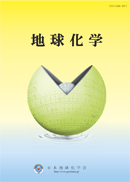All issues

Volume 48 (2014)
- Issue 4 Pages 207-
- Issue 3 Pages 109-
- Issue 2 Pages 53-
- Issue 1 Pages 1-
Volume 48, Issue 1
Displaying 1-4 of 4 articles from this issue
- |<
- <
- 1
- >
- >|
The Geochemical Society of Japan Award for Young Researchers 2012
-
Kana Nagashima2014 Volume 48 Issue 1 Pages 1-12
Published: March 25, 2014
Released on J-STAGE: June 26, 2014
JOURNAL FREE ACCESSAeolian dust in the sediments of East Asian marginal seas potentially records past variations in the westerly jet. However, extracting information about aeolian dust from these marine sediments is difficult because the sediments also contain detrital materials of the riverine input. Here we present a newly developed provenance-tracing method by using a combination of electron spin resonance (ESR) signal intensity of the E1′ center in quartz and crystallinity index (CI) of quartz, which we applied to Japan Sea sediment to identify aeolian dust within the sediment and estimate its provenance. We then reveal temporal changes in the provenance of aeolian quartz in Japan Sea sediments, which exhibit variations in harmony with Dansgaard–Oeschger (D–O) events during the last glacial period. The dominance of quartz with a Mongolian Gobi (Taklimakan) provenance during D–O cold (warm) periods suggests earlier (latter) seasonally northward progression of the westerly jet. The changes of the westerly jet path apparently critically affect the teleconnection between the climates of Asia and North Atlantic on a millennial timescale.View full abstractDownload PDF (2068K)
The Geochemical Society of Japan Award for Young Researchers 2009
-
Tsuyoshi Iizuka2014 Volume 48 Issue 1 Pages 13-30
Published: March 25, 2014
Released on J-STAGE: June 26, 2014
JOURNAL FREE ACCESSKnowledge of the nature and petrogenesis of Earth's early crust is central to understanding the early Earth. Here I discuss Lu–Hf and Hf–W isotope systematics of Archean samples that extended our knowledge of early crustal evolution. Recent developments in laser ablation inductively coupled plasma mass spectrometry (LA-ICPMS) allow us to obtain precise and accurate Lu–Hf isotopic data for zircon with high spatial resolution. The application of LA-ICPMS zircon Lu–Hf isotopic analysis to 4.0–3.6 Ga Acasta gneisses from northwestern Canada revealed that some of the early Archean samples including the Earth's oldest known rocks have sub-chondritic initial 176Hf/177Hf, indicating reworking of pre-existing crust. The finding is consistent with the presence of zircon xenocrysts with U–Pb ages up to 4.2 Ga in the Acasta gneisses. The implications are that Hadean granitoid crust was more widespread than previously thought, and that it had significantly contributed to the genesis of the early Archean crust. Recent high-precision W isotopic studies revealed positive 182W anomalies of up to 0.15ε in ~3.8 Ga Itsaq rocks from West Greenland and 2.8 Ga Kostomuksha komatiites from Russia. I explored the geologic significance of the 182W anomalies by combining with trace element and other isotopic data. In this context, the W isotopic data are interpreted to reflect early silicate differentiation events on Earth. Under the assumption that the bulk silicate Earth has a ~5% higher Sm/Nd than the chondrite average, the 182W–142Nd–143Nd chronometry constrains the age of the source mantle differentiation for the Itsaq samples to 4.53–4.49 Ga. The age may reflect the timing of silicate differentiation during a sequence of magma ocean solidification.View full abstractDownload PDF (1545K)
Frontiers in Geochemistry
-
Hiroshi Sakuma, Jun Kawano2014 Volume 48 Issue 1 Pages 31-38
Published: March 25, 2014
Released on J-STAGE: June 26, 2014
JOURNAL FREE ACCESSMineral/fluid interfaces are crucial for the fluid composition, crystal growth, recovery of toxic elements, enhanced oil recovery, and frictional strength of fault-forming minerals. The structures of the interfaces have been directly measured by the surface X-ray scattering method. In this review, we explain the X-ray crystal truncation rod (CTR) method, which is a kind of the surface X-ray scattering method. The CTR measurements can reveal the electron density profiles of the mineral/fluid interfaces with high resolution (<0.1 nm). A combination of the CTR measurements and molecular simulations is useful for understanding the hydration structures of adsorbed ions, structures of mineral surface, and electrical double layer.View full abstractDownload PDF (4844K)
Original paper
-
Shuji Tamamura, Maiko Akatsuka, Reo Ikawa, Masaru Koshigai, Satoru Shi ...2014 Volume 48 Issue 1 Pages 39-50
Published: March 25, 2014
Released on J-STAGE: June 26, 2014
JOURNAL FREE ACCESSNorthwestern part of Hokkaido is one of the production areas of natural gases in Japan, yet the origin of the methane dissolved in formation waters in the Quaternary Yuchi and Sarabetsu Formations, and the alluvium in this district has not been examined. This study aimed to manifest geochemical characteristics of the methane in these formations as well as those in the Neogene Koetoi Formation for comparison. The methane/(ethane+propane) ratio and the carbon isotope ratio of methane (δ13C (CH4)) indicate biogenic origin of the methane in the Yuchi Formation through to the alluvium. The high carbon isotope ratio of the methane (δ13C (CH4)>-60‰) in the Koetoi Formation is attributed to the high δ13C of coexisting carbon dioxide (>+15‰), implying that the methane is of biogenic origin. The hydrogen isotope ratio of the methane (δD (CH4)) indicates that both microbial acetate decomposition and carbon dioxide reduction have occurred in the upper part of the Sarabetsu Formation through to the alluvium, as methanogenic pathways. The δD (CH4) also indicates that carbon dioxide reduction have dominantly occurred in the Koetoi Formation through to the lower part of the Sarabetsu Formation.View full abstractDownload PDF (1292K)
- |<
- <
- 1
- >
- >|